Potřebujeme váš souhlas k využití jednotlivých dat, aby se vám mimo jiné mohly ukazovat informace týkající se vašich zájmů. Souhlas udělíte kliknutím na tlačítko „OK“.
ASTM F2998-14
Guide for Using Fluorescence Microscopy to Quantify the Spread Area of Fixed Cells (Withdrawn 2023)
Automaticky přeložený název:
Příručka pro použití fluorescenční mikroskopii kvantifikovat Spread oblasti pevných buněk
NORMA vydána dne 1.1.2014
Informace o normě:
Označení normy: ASTM F2998-14
Poznámka: NEPLATNÁ
Datum vydání normy: 1.1.2014
Kód zboží: NS-54829
Počet stran: 10
Přibližná hmotnost: 30 g (0.07 liber)
Země: Americká technická norma
Kategorie: Technické normy ASTM
Kategorie - podobné normy:
Anotace textu normy ASTM F2998-14 :
Keywords:
automated microscopy, cell morphology, cell cultures, segmentation, image analysis, fluorescence microscopy, cell staining, biomaterials, cytotoxicity, tissue engineering, cell therapy, stem cells, differentiation, quality control, ICS Number Code 07.080 (Biology. Botany. Zoology),07.100.01 (Microbiology in general)
Doplňující informace
| Significance and Use | ||||
|
5.1 Under well-controlled conditions, the quantitative evaluation of morphological features of a cell population can be used to identify changes in cellular behavior or state. Cell morphology changes may be expected when, for example, there is a response to changes in cellular cytoskeleton organization (1), a response of cells to toxic compounds, changes in differentiation state, and changes in adhesion properties of cells to a substrate by either chemical or mechanical-induced extracellular matrix-based (ECM-based) signaling pathways 5.2 It is important to note that the use of this technique for cells on or in a 3-D scaffold materials can complicate the interpretation of the data. The topographic transforms of the cells on a 3-D material may require full volumetric imaging and not just wide-field fluorescence imaging as described here. 5.3 the following are several examples of how this measurement can be used in a laboratory:— 5.3.1 Quantify Cellular Response to a Biomaterial—The measurement of cell spread area can be used to characterize the response of cells to biomaterials. For example, spreading of most cell types is extremely sensitive to the stiffness of the culture substrate (5), (6). It is important to note that cell response to an ECM may be dependent on the preparation of the matrix. For example, the same ECM proteins prepared in a fibrillar or non-fibrillar surface coating can result in different morphology response 5.3.2 Quality Control Metric for General Cell Culture Conditions—Cell spread area may be a useful metric for monitoring a change in cell culture conditions (that is, due to a serum component, pH, passage number, confluence, etc.). Cell morphology is often altered when cells are stressed and proceeding through cell-death related processes (that is, apotoposis). 5.3.3 Quality Control Metric for Biomaterial Fabrication—Cell spread area measurements may be useful for generating specifications for a biomaterial. These specifications may stipulate how a particular cell line responds to a fabricated biomaterial. 5.3.4 Quality Control Metric for Cell Line Integrity and Morphology Benchmarking—The morphology characteristic of a cell line grown under specified conditions should ideally be the same over time and in different laboratories. Thus, cell spread area measurements may be useful for validating that no significant changes in the cell cultures have occurred. This measurement provides a benchmark that is useful for establishing the current state of the cell culture and a metric that can be charted to increased confidence for within and between laboratory comparisons of cellular measurements (7). |
||||
| 1. Scope | ||||
|
1.1 This guide describes several measurement and technical issues involved in quantifying the spread area of fixed cells. Cell spreading and the distribution of cell spread areas of a population of cells are the result of a biological response that is dependent on intracellular signaling mechanisms and the characteristics of cell adhesion to a surface. Cell spread area is a morphological feature that can be responsive to alteration in the metabolic state or the state of stress of the cells. Changes in cell spread area can also indicate an alteration in the adhesion substrate that may be due to differences in manufacturing of the substrate material or be in response to extracellular matrix secretions. High quality measurement of cell spread area can serve as a useful metric for benchmarking and detecting changes cell behavior under experimental conditions. 1.2 The measurement described in this document is based on the use of fluorescence microscopy imaging of fixed cells and the use of image analysis algorithms to extract relevant data from the images. To produce robust cell spread area measurements, technical details involved in sample preparation, cell staining, microscopy imaging, image analysis and statistical analysis should be considered. Several of these issues are discussed within this document. 1.3 This standard is meant to serve as a guide for developing methods to reliably measure the area to which cells spread at a surface. This surface can be conventional tissue culture polystyrene or sophisticated engineered biomaterial surfaces. An example of a detailed procedure to measure the spreading area of cells on a tissue culture polystyrene surface is provided in the appendix section. 1.4 Cell morphology features such as cell spreading area and perimeter are generally reported in units of length. For example, spreading area per cell (that is, cell spread area) is likely reported in units of µm2. A spatial calibration standard is required to convert between numbers of pixels in a CCD camera image to µm2 as an SI unit. 1.5 This standard does not purport to address all of the safety concerns, if any, associated with its use. It is the responsibility of the user of this standard to establish appropriate safety and health practices and determine the applicability of regulatory limitations prior to use. 1.5.1 Sodium azide is used as a anti-bacterial reagent in the slide mounting media. This preserves the integrity of the mounting media. The toxicity of this reagent (for example, MSDS) should be considered before use of this reagent in large scale slide mounting procedures. |
||||
| 2. Referenced Documents | ||||
|
Podobné normy:
Historická
1.12.2012
Historická
1.10.2013
Historická
1.4.2012
Historická
1.3.2010
Historická
1.4.2012
Historická
1.1.2011
Doporučujeme:
Aktualizace technických norem
Chcete mít jistotu, že používáte pouze platné technické normy?
Nabízíme Vám řešení, které Vám zajistí měsíční přehled o aktuálnosti norem, které používáte.
Chcete vědět více informací? Podívejte se na tuto stránku.


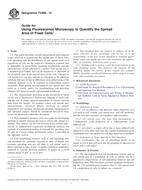
 ASTM D7847-12
ASTM D7847-12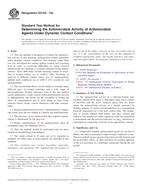 ASTM E2149-13a
ASTM E2149-13a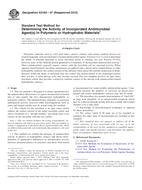 ASTM E2180-07(2012)..
ASTM E2180-07(2012).. ASTM E2186-02a(2010)..
ASTM E2186-02a(2010)..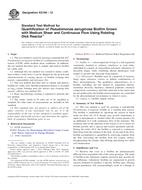 ASTM E2196-12
ASTM E2196-12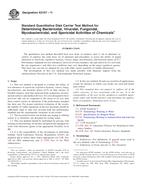 ASTM E2197-11
ASTM E2197-11
 Cookies
Cookies
